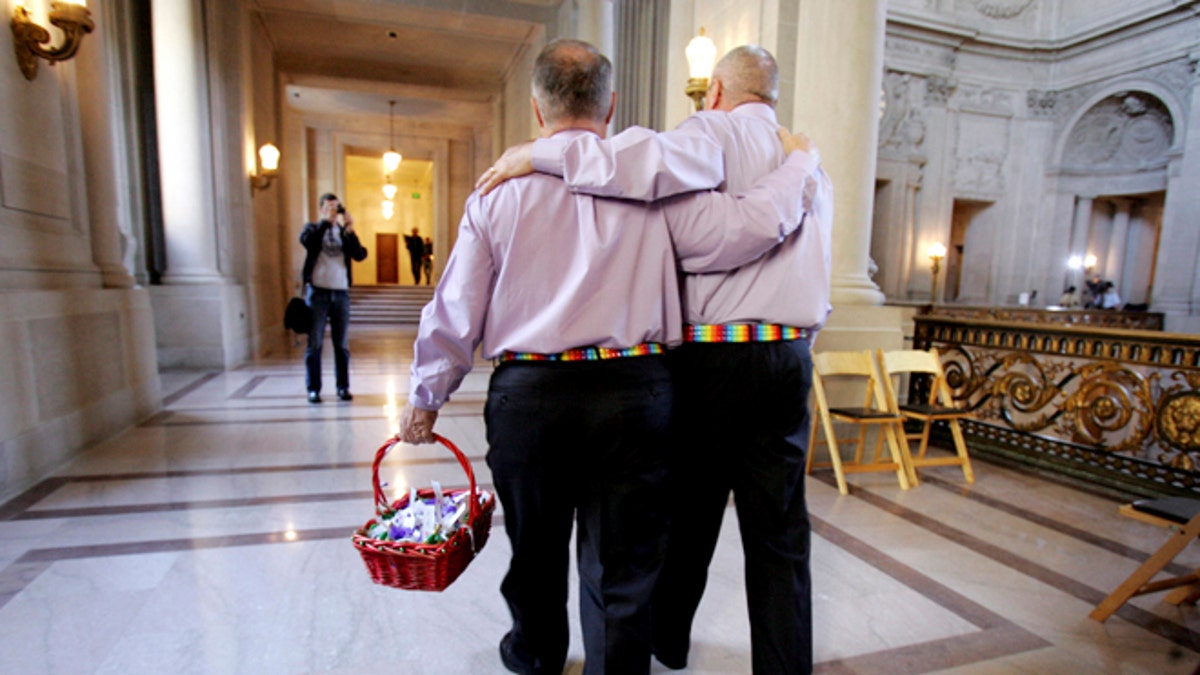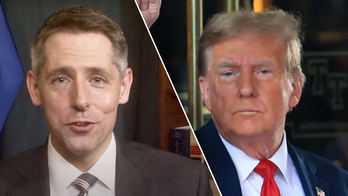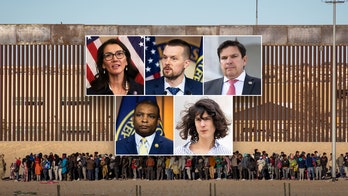
FILE 2008: A male couple inside San Francisco City Hall as they prepare to get married. San Francisco, Calif. (REUTERS)
The Supreme Court on Tuesday will hear arguments in highly anticipated cases about the right of same-sex couples to marry.
Just two years ago, the high court struck down part of the federal law that denied a range of government benefits to legally married same-sex couples.
The 2013 United States v. Windsor decision did not address the validity of state marriage bans. But lower courts judges across the country, with few exceptions, said the ruling compelled them to invalidate state laws that prohibited gay and lesbian couples from marrying.
The number of states allowing same-sex marriage has grown rapidly.
As recently as October, just over one-third of the states permitted same-sex marriage. Now, same-sex couples can marry in 36 states and the District of Columbia.
The justices on Tuesday will hear extended arguments -- scheduled to run 2 1/2 hours. The cases before the court come from Kentucky, Michigan, Ohio and Tennessee, all of which had their marriage bans upheld by the federal appeals court in Cincinnati in November. That appeals court is the only one that has ruled in favor of the states since the 2013 decision.
Two related issues would expand the marriage rights of same-sex couples. First, do same-sex couples have a constitutional right to marry or can states continue to define marriage as the union of a man and a woman?
The second is must states that won't allow some couples to marry recognize valid same-sex marriages from elsewhere?
Marriage-rights supporters essentially argue states lack any valid reason to deny the right to marry, which the court has earlier described as fundamental to the pursuit of happiness.
They say state laws that allow only some people to marry violate the Constitution's guarantee of equal protection under the law and make second-class citizens of same-sex couples and their families.
Same-sex couples say that preventing them from marrying is akin to a past ban on interracial marriage, which the Supreme Court struck down in 1967.
State argue that they have always set the rules for marriage and that voters in many states have backed, sometimes overwhelmingly, changes to their constitutions to limit marriage to a man and a woman.
They say a lively national debate is underway and there is no reason for courts to impose a solution that should be left to the political process. The states also argue that they have a good reason to keep defining marriage as they do. Because only heterosexual couples can produce children, it is in the states' interest to make marriage laws that encourage those couples to enter a union that supports raising children.
The Obama administration is backing the right of same-sex couples to marry, though its argument differs in one respect. The plaintiffs say that the state laws should fall, no matter what standard the court applies. The administration calls for more rigorous scrutiny than courts ordinarily apply to most laws, saying it is appropriate when governments discriminate against a group of people. That already is the case for claims that laws discriminate on the basis of race, sex and other factors. But the administration is silent about what the outcome should be if the court does not give gays the special protection it has afforded women and minorities.
The Justice Department's decision to stop defending the federal anti-marriage law in 2011 was an important moment for gay rights and President Barack Obama declared his support for same-sex marriage in 2012.
If the court strikes down the state bans, the ruling would invalidate the remaining anti-gay marriage laws in the country. If the court limits its ruling to requiring states to recognize same-sex unions, couples in states without same-sex marriage presumably could get married elsewhere and then demand recognition at home.
If the court rules for the states on both questions, the bans in 14 states would survive.
Some states that had their marriage laws struck down by federal courts might seek to reinstate prohibitions on gay and lesbian unions. Questions also could be raised about the validity of some same-sex weddings. Many of these problems would be of the Supreme Court's own making.
That’s because from October to January, the justices first rejected appeals from states seeking to preserve their marriage bans, then allowed court rulings to take effect even as other states appealed those decisions. The result is that the court essentially allowed the number of states with same-sex marriage to double.




